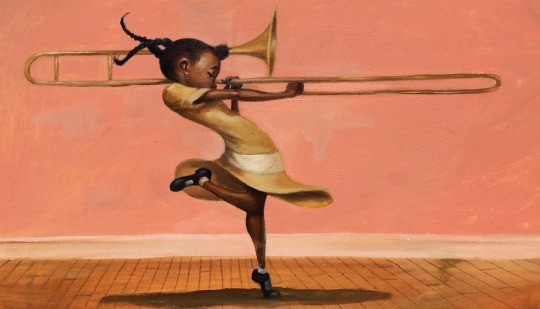#little melbe and her big trombone
Text
March is the month of women's history month. Let's start off the month by recognizing some of the picture books that bring forward some of the difficult experiences and perspectives women had in overcoming sexism, racism, and injustice.

Little Melba and Her Big Trombone • {Katheryn Russell Brown | 2014}
Little Melba and Her Big Trombone is a 40-page picture book written by Katheryn Russell Brown, and it was published in 2014 for young children between the ages of 3 - 9 years old.
The story is based on a girl named Melba who loved music her whole life — music takes over her mind when she sleeps, she hums along to radio tunes, and is constantly daydreaming her own beats and lyrics. At the age of seven, Melba got her own big, shiny trombone and quickly fell in love with it by teaching herself how to play — she struggled at first, but her family continued to support her journey. As Melba becomes a teenager, she joins the school band and is seen as a gifted musician. Melba continues to pursue her passion for jazz by joining a band led by Gerald Wilson, who was the trumpet player of the band, and tours around the country. Soon later, Melba becomes a famed trombone player, arranger, and composer by collaborating with some of the greatest jazz hits of the twentieth century for Randy Weston, Duke Ellington, Billie Holiday, Quincy Jones, and many more.
Based on this picture book, the story was very encouraging in terms of seeing how Melba was able to work her way to becoming a famous trombone player, overcoming her struggles as a black woman. This is illustrated through the images when Melba was primarily the only woman in the band, which indicates that the music industry is typically dominated by men, and it is often rare to see women playing the trombone. That said, some of the important themes this book touches on are the power of music, overcoming the obstacles of race and gender, family support, and perseverance. And lastly, this book also sheds light on Melba's impactful contribution to the music industry by paving the way for future women musicians to be taken seriously and not overlooked.
Looking at the illustrations of the picture book, the book is illustrated with crisp, powerful images by Frank Morrison. The illustrations of the book are primarily done with the use of paint, using an orange-brown color palette. The illustrations within the books also tie the overall story together by the use of a dynamic expression of the facial features as well as the body language to emphasize her love for music. To add on, each of the illustrations adds powerful importance to the message, for example, Melba being isolated from her band members who are all men which reinforces the theme of sexism.
#little melbe and her big trombone#picture books#childrens books#children books#book review#book recommendations#women history#women history month#books to read#books and reading#reading recommendations#book#childrenbook#music#racisim#sexism#sexist#discrimination#frank morrison
3 notes
·
View notes